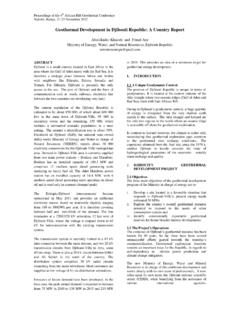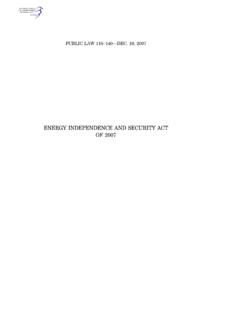Transcription of The Values of Geothermal Energy
1 The Values of Geothermal Energy October 2013. The Values of Geothermal Energy : A Discussion of the Benefits Geothermal Power Provides to the Future Power System 1. The Values of Geothermal Energy October 2013. Table of Contents Introduction ..4. Relevant Terms and Definitions ..4. The Changing Power Market ..7. Firm Power: Geothermal the Clean, Cost Effective, Baseload Resource ..8. Replacing Baseload Coal ..8. A Substitute for Natural Gas ..9. Flexible Power: Geothermal Power's Ability to Adapt to Variability ..10. The Need for a Flexible Power System ..10. The Realities of a 21st Century Power System & Variability.
2 11. Flexible Power ..11. Ancillary Services, Integration, Transmission Costs ..12. Other Benefits of Geothermal Power ..13. Employment and Economic Development ..13. Small Land Footprint ..14. Near Zero Reliability: Predictable and Long-lasting ..15. Conclusion ..16. References ..17. Prepared and Written by Benjamin Matek, Geothermal Energy Association Brian Schmidt, Geothermal Resources Council Cover Photos Courtesy of Geothermal Inc. (top & bottom left), Ormat Technologies Inc. (top right & bottom right). KEYWORDS: PROCUREMENT, VARIABLE Energy RESOURCES, ANCILLARY SERVICES, VALUATION, NATURAL GAS, Geothermal POWER, GREENHOUSE GAS EMISSIONS, RAMPING, COAL, GREEN JOBS, RENEWABLES, BASELOAD, FLEXIBLE POWER, SPINNING RESERVE, PEAKING.
3 Geothermal Energy Association 209 Pennsylvania Ave. SE. Washington, DC 20003. (202) 454-5291. Geothermal Resources Council 2001 Second Street, Suite 5. Davis, CA 95618-5476. (530) 758-2360. 2. The Values of Geothermal Energy October 2013. Acknowledgments: The authors would like to give a special thank you to Bob Sullivan, Charlene Wardlow, Josh Nordquist and Heidi Bethel from Ormat Technologies Inc.; Domenic Falcone from Domenic J. Falcone Associates Inc.; Doug Glaspey from Geothermal Inc.;. Karl Gawell and Leslie Blodgett from the Geothermal Energy Association; Paul Brophy from EGS Inc.
4 ; Richard Campbell from CH2M HILL; and Steve Ponder from the Geothermal Resources Council for their invaluable insight and contributions on this project. 3. The Values of Geothermal Energy October 2013. Introduction Geothermal power offers both firm and flexible solutions to the changing power system by providing a range of services including but not limited to baseload, regulation, load following or Energy imbalance, spinning reserve, non-spinning reserve, and replacement or supplemental reserve. It is well known that Geothermal plants can operate 24 hours a day with a steady output, regardless of environmental conditions, and are not subject to the unpredictability and voltage swings that variable Energy resources (VER) face and, hence, can fulfill the necessary role as a renewable baseload power source.
5 As aging baseload fossil fuel plants retire, Geothermal plants can provide the generation these plants have historically provided to the power system. Geothermal plants can also ramp up or down quickly, allowing them to adjust to the changing needs of the power system and act as a flexible power source in addition to baseload. The increasing percentage of electricity produced from VER, such as solar and wind, is placing an escalating level of stress on an aging power system designed for fossil fuels. The varying output can cause voltage swings in transmission lines, potentially creating power surges and blackouts.
6 This combination of firm and flexible power positions Geothermal Energy as an ideal candidate to fill several roles historically performed by emission-heavy fossil fuels, such as baseload, regulation, load- following, and reserve functions typically reserved for coal and/or natural gas plants. In addition to considerable environmental advantages over fossil fuels, Geothermal plants generally lack the fuel costs of other baseload sources, or the ancillary and transmission costs associated with variable Energy resources that often equate to the long-term stability in Energy costs. Looking beyond these specific benefits, Geothermal has a number of other attractive features, including: Geothermal power production has a positive impact on local economies, and creates significantly more jobs per megawatt than natural gas.
7 Geothermal power has a smaller land footprint than most other Energy sources, particularly when compared with other renewables. Geothermal power has very low emission levels. Binary plants produce near-zero GHG emissions while flash and dry steam plants represent a significant reduction compared to fossil fuel based generation. Geothermal power's established history of consistent output demonstrates a level of reliability unmatched by other renewables and fossil fuel based generation. Relevant Terms and Definitions Ancillary services are defined by FERC as the services necessary to support the transmission of electricity from a supplier to a purchaser, given the obligations of a control area and that area's transmitting utilities to maintain reliable operations of the interconnected transmission system.
8 There are six different kinds of ancillary services: scheduling and dispatch, reactive power and voltage control, loss compensation, load following, system protection, and Energy imbalance. Balancing Authority Area is a metered segment of the electric power system in which electrical balance is maintained. In a balancing authority area, the total of all generation must equal the total of all loads (as supplemented by electrical imports into and exports out of the area). 4. The Values of Geothermal Energy October 2013. Baseload Power (Firm Power) is the minimum amount of power that a utility or distribution company must generate for its customers, or the amount of power required to meet minimum demands based on reasonable expectations of customer requirements.
9 Baseload Values typically vary from hour to hour in most commercial and industrial areas. Large baseload units also tend to have lower operating costs relative to other fossil-fueled facilities. Capacity Factor/ value of a power plant is the ratio of its actual output over a period of time to its potential output if it were possible for it to continuously operate at full nameplate capacity. To calculate the capacity factor, the total amount of Energy produced by the power plant during a period of time is divided by the amount of Energy the plant would have produced at full capacity. Capacity factors vary greatly depending on the type of fuel that is used and the design of the plant.
10 The capacity factor should not be confused with the availability factor, capacity credit (firm capacity) or with efficiency. Contingency Spinning Reserve is generation (or responsive load) that is poised, ready to respond immediately, in case a generator or transmission line fails unexpectedly. Spinning reserve begins to respond immediately and must fully respond within 10-15 minutes. Enough contingency reserve (spinning and non-spinning) must be available to deal with the largest failure that is anticipated. Demand response is not a single technology or rate which a power plant can be activated.







